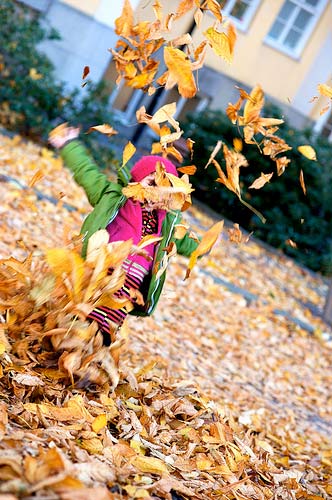I have very fond memories of raking leaves as a child.
Growing up in the suburbs, we were lucky to have a big backyard. But, in the fall, in the midst of planning our Halloween costumes and carving our pumpkins, my sisters and I would always get tasked with raking the leaves. Yet, what I remember most now about this potentially tedious task is the giant leaf piles we would create. In the very back of our yard, we had a tree house with a huge ramp that you could bike, sled or peddle a three-wheeler down and into the yard. So, when we were tasked with raking the leaves, we would gather our neighborhood friends, have them help us rake the leaves into an enormous pile at the end of the ramp and then we would each take turns choosing our method down. I remember the feeling of excitement as I headed towards the great pile and being welcomed by the splash of crunchy leaves around me!
While we would eventually have to actually rake the leaves into smaller piles and into bags, the playtime that we got to enjoy while doing our “chores” made the hard work worth it. It is surprising to me that today many children are not interested in playing outside or encouraged to do so. In fact, studies show that the average American boy or girl spends just four to seven minutes in unstructured outdoor play each day and more than seven hours each day in front of an electronic screen.
The term “nature deficit disorder” was coined by Richard Louv in his book Last Child in the Woods to explain this societal disconnect that America’s youth have with nature. With less access to natural spaces, competition from television and computers, traffic and time pressures, kids have less and less exposure to playtime in nature.
Yet, research shows that getting outside has tremendous benefits for kids. For example:
- Trees and green spaces help children cope with and reduce stress.
- Children are more creative when playing in greenspaces.
- Play protects children’s emotional development, whereas loss of free time and a hurried lifestyle can contribute to anxiety and depression.
- After a walk in the park or playing in greenspaces, children with ADD displayed fewer symptoms.
Thus, whether or not kids have access to large backyards and treehouses, I feel kids need to be encouraged to get outside, play and enjoy nature in some way. Fall offers such a variety of fun things to do before the weather gets unpleasant. So, whether it is walking around to see the colorful changing leaves, picking the seasonal fruits and veggies in a local urban orchard or jumping into massive piles of leaves, encourage the kids around you to go out and play! And, perhaps you might just find yourself playing like a kid again.
Is there a favorite fall outside activity that reminds you of being a kid?
